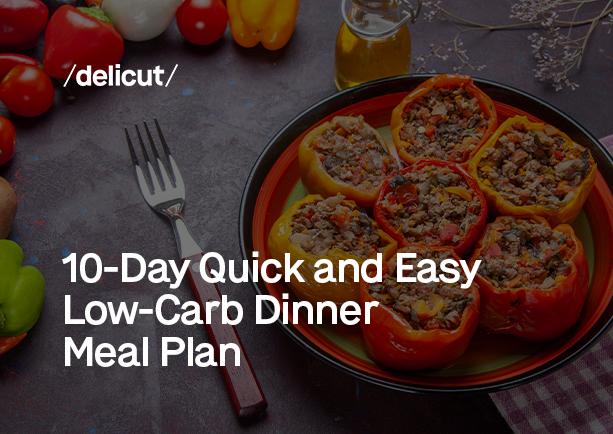10-Day Quick and Easy Low-Carb Dinner Meal Plan

Did you know that replacing high-carb foods with low-carb alternatives can significantly reduce your risk of chronic diseases? Studies have shown that low-carb diets aid in weight loss and help manage conditions such as diabetes and cardiovascular diseases. You can achieve better health outcomes by reducing sugar and processed foods and increasing your nutrient-dense vegetables and protein intake.
Low-carb diets have gained immense popularity for their ability to promote weight loss, stabilise blood sugar levels, and improve overall health. The secret lies in choosing the right nutritious and delicious foods.
Join us on this culinary journey, where each day brings a new, mouth-watering dinner option. Let's dive into this low-carb meal plan and discover how easy and enjoyable healthy eating can be!
How to Maintaining a Low-Carb Diet?
- Plan Your Meals: Prepare your meals in advance to avoid last-minute high-carb choices.
- Stock Healthy Snacks: Keep low-carb snacks like nuts, cheese, and veggies readily available.
- Stay Hydrated: Drink plenty of water to help manage hunger and support overall health.
- Read Labels: Check nutrition labels to avoid hidden sugars and high-carb ingredients.
- Incorporate Variety: Use different vegetables, proteins, and healthy fats to keep meals interesting.
What are the Health Benefits of a Low-Carb Diet?
- Weight Loss: Helps reduce overall calorie intake and boosts fat burning.
- Blood Sugar Control: Stabilises blood sugar levels, which is beneficial for diabetics.
- Improved Heart Health: Lowers bad cholesterol and increases good cholesterol.
- Reduced Appetite: Promotes satiety and reduces cravings for high-carb foods.
- Enhanced Mental Clarity: Provides steady energy levels and improves focus and cognitive function.
10-Day Quick and Easy Low-Carb Dinner Meal Plan
This 10-day quick and easy low-carb dinner meal plan is designed to help you enjoy various meals without the hassle of complicated recipes or lengthy cooking times. Each meal reduces added sugar and unhealthy fats while incorporating wholesome ingredients like lean proteins, fresh vegetables, and healthy oils. Let's dive into this low-carb meal plan and discover how easy and enjoyable healthy eating can be!
Day 1: Herb-Crusted Chicken with Quinoa Salad
Calories: 450 kcal
Ingredients:
- 1 chicken breast
- 1 cup cooked quinoa
- Mixed greens (spinach, arugula)
- Olive oil
- Herbs (thyme, rosemary)
- Salt and pepper
Preparation Steps:
- Preheat the oven to 375°F (190°C).
- Coat the chicken breast with olive oil, herbs, salt, and pepper.
- Bake for 25-30 minutes until fully cooked.
- Serve with quinoa and mixed greens drizzled with olive oil.
Day 2: Lemon Garlic Shrimp with Zoodles
Calories: 400 kcal
Ingredients:
- 200g shrimp, peeled and deveined
- 2 zucchinis, spiralised
- 2 cloves garlic, minced
- 1 lemon, juiced
- Olive oil
- Salt and pepper
Preparation Steps:
- Heat olive oil in a pan and sauté garlic until fragrant.
- Add shrimp and cook until pink.
- Add lemon juice, salt, and pepper.
- Toss in zoodles and cook for an additional 2-3 minutes.
Day 3: Grilled Salmon with Avocado Salsa
Calories: 430 kcal
Ingredients:
- 1 salmon fillet
- 1 avocado, diced
- 1 tomato, diced
- 1/4 red onion, finely chopped
- Lime juice
- Olive oil
- Salt and pepper
Preparation Steps:
- Preheat the grill to medium-high heat.
- Season salmon with olive oil, salt, and pepper.
- Grill for 4-5 minutes on each side.
- Mix avocado, tomato, red onion, lime juice, salt, and pepper to make salsa.
- Serve salmon topped with avocado salsa.
Day 4: Veggie-Stuffed Peppers
Calories: 380 kcal
Ingredients:
- 4 bell peppers
- 1 cup quinoa, cooked
- 1 cup black beans, cooked
- 1 cup corn kernels
- 1 cup diced tomatoes
- 1 cup shredded cheese (optional)
- Olive oil
- Salt and pepper
Preparation Steps:
- Preheat the oven to 375°F (190°C).
- Cut the tops off the bell peppers and remove the seeds.
- Mix quinoa, black beans, corn, tomatoes, olive oil, salt, and pepper.
- Stuff the peppers with the mixture and top with cheese if desired.
- Bake for 25-30 minutes until peppers are tender.
Day 5: Moroccan-Spiced Beef Kebabs
Calories: 470 kcal
Ingredients:
- 200g beef sirloin, cubed
- 1 bell pepper, cubed
- 1 red onion, cubed
- 1 zucchini, sliced
- Moroccan spice blend
- Olive oil
- Salt and pepper
Preparation Steps:
- Preheat the grill to medium-high heat.
- Toss beef and vegetables in olive oil, Moroccan spices, salt, and pepper.
- Thread beef and vegetables onto skewers.
- Grill for 8-10 minutes, turning occasionally.
Day 6: Eggplant Parmesan
Calories: 390 kcal
Ingredients:
- 1 large eggplant, sliced
- 1 cup marinara sauce
- 1 cup shredded mozzarella cheese
- 1/2 cup grated Parmesan cheese
- Olive oil
- Salt and pepper
Preparation Steps:
- Preheat the oven to 375°F (190°C).
- Brush eggplant slices with olive oil, salt, and pepper.
- Bake for 20 minutes until tender.
- Layer eggplant slices, marinara sauce, and cheese in a baking dish.
- Bake for an additional 20 minutes until cheese is melted and bubbly.
Day 7: Chicken Avocado Salad
Calories: 350 kcal
Ingredients:
- 1 chicken breast, grilled and sliced
- 1 avocado, diced
- Mixed greens (lettuce, spinach)
- 1/4 red onion, sliced
- Olive oil
- Lemon juice
- Salt and pepper
Preparation Steps:
- Toss mixed greens with olive oil, lemon juice, salt, and pepper.
- Top with grilled chicken, avocado, and red onion.
- Serve immediately.
Day 8: Shrimp and Cauliflower Rice
Calories: 360 kcal
Ingredients:
- 200g shrimp, peeled and deveined
- 1 head cauliflower, grated into rice-sized pieces
- 1 bell pepper, diced
- 1 cup peas
- Olive oil
- Soy sauce
- Salt and pepper
Preparation Steps:
- Heat olive oil in a pan and sauté shrimp until pink.
- Remove shrimp and set aside.
- Add bell pepper and peas to the pan, and cook for 5 minutes.
- Add cauliflower rice, soy sauce, salt, and pepper.
- Return shrimp to the pan and mix well before serving.
Day 9: Tuna Nicoise Salad
Calories: 370 kcal
Ingredients:
- 1 can tuna, drained
- 1 cup green beans, blanched
- 2 hard-boiled eggs, sliced
- Mixed greens
- 1/4 red onion, sliced
- Olive oil
- Lemon juice
- Salt and pepper
Preparation Steps:
- Toss mixed greens with olive oil, lemon juice, salt, and pepper.
- Top with tuna, green beans, eggs, and red onion.
- Serve immediately.
Day 10: Turkey Meatballs with Spaghetti Squash
Calories: 410 kcal
Ingredients:
- 1 spaghetti squash
- 1 lb ground turkey
- 1 egg
- 1/4 cup grated Parmesan cheese
- 1/4 cup almond flour
- 1 cup marinara sauce
- Olive oil
- Salt and pepper
Preparation Steps:
- Preheat oven to 375°F (190°C).
- Cut spaghetti squash in half, remove seeds, and bake for 40 minutes.
- Mix ground turkey, egg, Parmesan, almond flour, salt, and pepper.
- Form into meatballs and bake for 20 minutes.
- Heat marinara sauce in a pan, add meatballs.
- Scrape spaghetti squash into strands and top with meatballs and sauce.
Conclusion
By following this meal plan, you'll experience the benefits of a low-carb diet, such as weight loss, improved blood sugar control, and better heart health. You'll also discover that healthy eating can be flavorful and satisfying. Remember to plan your meals, stock up on healthy snacks, stay hydrated, and enjoy the variety of dishes a low-carb diet offers.
FAQs
1. What are the benefits of a low-carb dinner meal plan?
A low-carb dinner meal plan helps stabilise blood sugar levels, reducing insulin spikes that can lead to weight gain and energy crashes. It promotes satiety with high-protein and healthy-fat foods, making you feel full longer. Additionally, it supports heart health by lowering bad cholesterol levels and improving overall cardiovascular function.
2. How does a low-carb diet support weight loss and management?
A low-carb diet supports weight loss by reducing overall calorie intake and enhancing fat burning. By minimising carbohydrate consumption, the body turns to stored fat for energy, leading to weight loss. It also helps control hunger and cravings, making it easier to maintain a calorie deficit.
3. What are the key principles of a low-carb dinner meal plan?
Key principles of a low-carb dinner meal plan include focusing on whole, unprocessed foods, incorporating lean proteins, healthy fats, and plenty of vegetables, avoiding added sugars and refined carbs, and opting for nutrient-dense alternatives like leafy greens, nuts, seeds, and low-carb fruits.
4. How can meal prepping help maintain a low-carb dinner plan?
Meal prepping helps maintain a low-carb dinner plan by ensuring you have healthy, low-carb options readily available. It saves time and reduces the temptation to opt for high-carb convenience foods. Planning and preparing meals in advance can help you stick to your dietary goals and avoid last-minute unhealthy choices.
5. What are some common mistakes to avoid when following a low-carb dinner plan?
Common mistakes include not eating enough fibre, relying too heavily on processed low-carb foods, and neglecting to balance protein intake with healthy fats. Avoiding variety and not planning meals can lead to nutritional deficiencies and cravings for high-carb foods.
6. How can portion control be managed effectively in a low-carb dinner meal plan?
Portion control can be managed by using smaller plates, measuring serving sizes, and being mindful of hunger cues. Balancing meals with a good mix of protein, fats, and fibre-rich vegetables can help you feel full and satisfied, preventing overeating. Preparing meals in advance and avoiding second helpings can also aid in maintaining proper portion sizes.
Trending Searches:
Meal Plan Dubai | Affordable Meal Plans Abu Dhabi | Meal Plan Ajman | Meal Plan Al In | Meal Plan Sharjah | Meal Plan Subscription
Related Blogs
Why do most people in the UAE get their calories wrong
Dec 8, 2025 | 6DASH Diet Meal Plan
Nov 11, 2025 | 8Fatty Liver Meal Plan
Oct 31, 2025 | 8Pregnancy Diet Meal Plan
Oct 27, 2025 | 82000 Calorie Meal Plan
Oct 1, 2025 | 8Intermittent Fasting Diet Plan
Sep 5, 2025 | 81000 Calorie Meal Plan
Sep 5, 2025 | 8High-Protein Meal Plans
Sep 5, 2025 | 8How to Choose the Right Meal Plan for Your Fitness Goals
Sep 5, 2025 | 8The GM diet plan: Is it possible to shed fat in just 7 days?
Sep 5, 2025 | 8






